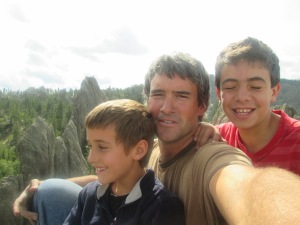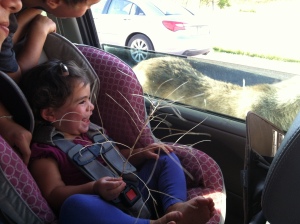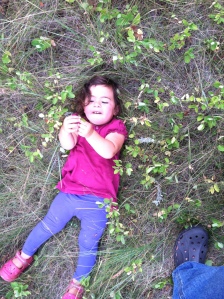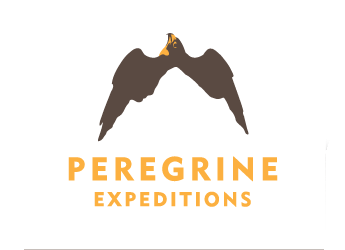The Black Hills are a cluster of forested mountains that sit like an oasis smack in the middle of the North American steppe or “Great Plains” and are a patch work of National Forest, National Park, State Park and private land that straddles the boarder of Wyoming and South Dakota. In 2012 the United Nations general assembly recommended that the Black Hills be returned to the previous stewards of the land, the Lakota Native American Tribe. What is to become of these recommendations is to be determined.
For us the attraction was nothing knew – some of the best summer rock climbing in the country. A large portion of the climbing takes place in the Needles district of Custer State Park. Let me tell you, if there is a better place for a couple young bucks like Jacob and Elias to get psyched on climbing I’m all ears.
The very hilly landscape is blanketed by a pin cushioned like forest of granite spires with 300 foot tall monoliths and 50 foot turrets which are easily accessible via trails amongst grassy Ponderosa forests. If you wanted to climb them all good luck, you could probably do it in three life times, maybe. The climbing is a play ground of cool fins, arrets and bubbly faces most of which almost always top out on some sort of peak or summit. It’s a great place to climb if you don’t own much climbing gear because you won’t need it. Cracks and places for natural pro are rare and the route setters were cheap, meaning bolts are few and far between.
I hope that when and if the Lakota get their land back the door stays open to climbing. And I do hope they get it back. A large portion of the Southern Black Hills, nearby hilly forests and rolling grasslands make up Custer State Park, named after General Custer and famous for fantastic animal viewing.
I haven’t had the opportunity to read in great depth about why the UN Assembly on Indigenous Peoples recommended returning the park to the Lakota however I will say, you don’t need to read much to get a gist that things have not yet been set right. The area encompassing Custer State Park is very important to the Lakota. In 1868 a treaty was signed by the United States Government stating that this land would belong to the Lakota people forever. In 1874 General Custer, who was given the task of rounding up Native tribes on the plains and placing them on their assigned reservations, marched into French Creek in the present day town of Custer and found gold. He then opened up the Black Hills to a massive gold rush scrapping the US-Lakota treaty. Eventually the Lakota would be pushed onto the current Pine Ridge Reservation. However they weren’t pushed there by Custer himself. The Lakota, the Cheyenne and the Arapahoe native tribes settled their age old differences (which included the Lakota taking the Black Hills from the Cheyenne in 1776) and ended Custer’s murderous rampage along with the whole of the 7th US Calvary at the Battle of Little Big Horn in South East Montana where Custer met his “Last Stand”.
It could be said that although Native rights have not been respected in this area, the rights of non-humans are currently well valued. The park systems in this region remains one of the last North American sanctuaries for the American Bison, as well as home to large numbers of Elk herds, Mule Deer and White Tailed Deer, Cougar, Pronghorn Antelope, Prairie Dog and many other animals including wild donkeys that are very eager to meet you.
At the southern tip of 111 square miles of Custer State Park is Wind Cave National Park. We visited the Wind Cave on our second day in the region. Wind Cave is one of the longest explored caves in the world with 140 miles of cave now mapped (residing under one mile of surface area) which leaves an estimated 90% of the whole cave yet to be mapped. The discovery of this cave is due to the “wind” that flows out of the cave during low pressure. The breeze streams out of the cave’s only known natural opening which is the size of a volley ball. The first explorers of the cave not only squeezed themselves through this absurdly small opening but they squirmed for hours on end by candle light. A large opening was eventually built in the name of prospecting, where nothing of value was found, which made it possible for a young man named Alvin McDonald to lead tourists through the cave as early as 1892…all by candle light dragging sting behind him to find his way out. Today being guided through this cave is easy, fun and fascinating. One of the real gems of the Park is the fact that there are 44 more square miles of prairie protected above ground allowing one of the 4 largest and genetically pure herds of wild buffalo to roam free along with all of the other wild animals found in the region.
The majority of our time in this area was spent in the Needles District of Custer State Park. Here we stayed in a secluded hilltop campsite next to Sylvan Lake. Along with hiking and climbing we also found a quiet routine at camp which included schooling, playing in the forest, building forts and time around the camp fire with other travelers, including a British math teacher who gave Jacob math lessons in exchange for climbing lessons.
On September 11th we packed up camp and began our eastward migration but not without stopping first at Mount Rushmore.









